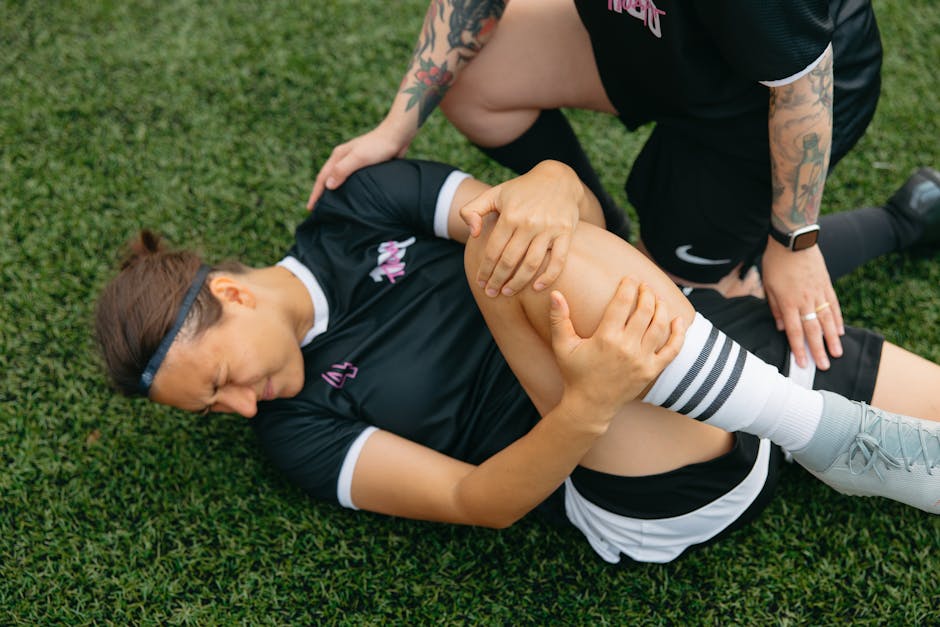Introduction
Why Fast and Accurate Injury Response Matters
In high-impact sports, injuries are inevitable—but how you respond can make all the difference. Immediate, accurate attention can prevent minor issues from turning into long-term setbacks. Whether you’re a coach, a parent, or an athlete, knowing what to look for and acting quickly can protect both health and future performance.
Key reasons quick action is critical:
Prevent escalation: Minor sprains can become severe tears if ignored.
Minimize downtime: Prompt care often shortens recovery time.
Boost athlete confidence: Athletes trust teams that prioritize safety.
Soreness vs. Real Damage: How to Tell the Difference
Feeling sore after a tough game or intense practice is normal. However, certain indicators suggest something more serious is at play. Recognizing these differences is essential to avoid exacerbating an injury.
Watch for:
Pain that increases over time instead of fading
Visible swelling or bruising that persists
Limited range of motion or inability to bear weight
Sharp or stabbing pain, especially during movement
The High Cost of Ignoring the Signs
Pushing through pain may seem tough, but the results can be costly. Overlooking an injury can result in:
Extended recovery periods that jeopardize the season
Permanent damage to joints, muscles, or ligaments
Higher medical costs for corrective treatments down the line
Mental setbacks, including hesitation or fear during play
Ignoring early warning signs not only hurts performance—it can derail an athlete’s entire season or even career. Prioritizing safety early is always the smarter play.
Recognizing Common Game-Day Injuries
Spotting injuries quickly and accurately on game day is critical—not just for performance, but for safety. Knowing the signs can help coaches, trainers, and even players make the right call fast.
Sprains and Strains
These are among the most common game-day injuries, especially in high-impact sports. While they often seem minor, mismanaging them can lead to longer recovery times or chronic issues.
Sprains affect ligaments (the tissue connecting bones)
Warning signs: swelling, bruising, and joint instability
Strains impact muscles or tendons
Symptoms: sharp or aching pain, muscle spasms, weakness
Watch for: limited range of motion and pain during movement
Concussions: Subtle but Serious
Concussions can be harder to recognize and require immediate attention, even if the athlete initially feels “fine.”
Common signs:
Dizziness or loss of balance
Headache, confusion, or blurred vision
Sensitivity to light or noise
Delayed response to questions
Always err on the side of caution: remove the player and assess right away
Dislocations and Fractures
When bones or joints appear out of place, it’s not just painful—it’s potentially dangerous.
Dislocations: often visible as a misaligned joint and accompanied by intense pain and immobility
Fractures: may present as swelling, bruising, or deformity
Never attempt to reset a bone in the field—immobilize and seek medical help ASAP
Key Red Flags: When to Stop Play Immediately
Some symptoms shouldn’t be ignored under any circumstance:
Inability to bear weight or move the affected limb
Visible deformity in a joint or bone
Loss of consciousness or severe confusion
Pain that increases sharply with touch or movement
If these signs are present, end play, assess the athlete, and if in doubt, call for emergency assistance.
Importance of Communication
Injuries don’t always look dramatic. That’s why communication is vital.
Encourage players to speak up about how they feel—even small tweaks or dizzy moments matter
Create an environment where reporting pain isn’t seen as weakness, but smart prevention
For a deeper dive into game-day injury assessment, check out Injury Recognition and Recovery.
Conclusion

The Inevitable Reality of Game-Day Injuries
Injuries are simply part of the game—whether you’re playing professionally or recreationally. But the difference between a setback and a season-ender often comes down to how you respond in the moments that follow. Smart handling starts with the right mindset and protocols in place long before the whistle blows.
The Winning Formula: Speed, Awareness, Smart Recovery
To ensure the best outcomes for athletes, coaches and medical teams must prioritize three key actions:
Speed: Quick assessment and intervention can minimize long-term damage.
Awareness: Knowing the signs of injury and staying alert to subtle changes in performance or behavior is essential.
Smart Recovery: Rushing recovery often leads to re-injury. A structured, medically guided recovery plan gives athletes the best chance of a full return.
Play the Long Game
Every athlete wants to return to the field as soon as possible—but pushing too hard, too soon can backfire. Prioritize:
Long-term health over quick wins
Consistent rehab instead of sporadic rest
Medical advice rather than peer pressure or personal ambition
In the end, protecting your body today ensures you can keep showing up tomorrow.
Immediate Steps: What to Do On the Field
When injuries hit mid-game, there’s no time for guessing. The first move? Apply the R.I.C.E. method: Rest the player immediately to prevent more stress on the injury. Ice the area for 15–20 minutes to reduce swelling. Compress with a bandage or wrap—but not so tight it cuts off circulation. Then elevate the injured limb above heart level if you can. Simple, but effective.
Now, know when to escalate. If a player can’t stand, has severe swelling, intense pain with limited movement, or shows signs of a head injury—call in emergency medical help right away. Better to overreact than miss something serious.
If the injury looks minor, get them sidelined and monitored. Keep them still, keep them calm, and don’t let anyone start stretching, walking it off, or “testing it.” You’re managing trauma, not coaching through it.
Every team—no matter the level—needs a basic emergency protocol. That includes knowing who’s in charge in a crisis, keeping a stocked first aid kit nearby, and having contact info for local emergency care. Run drills once or twice a season, so when the real thing happens, you’re not improvising.
Smart reactions on the field can stop a bad injury from becoming a career-ending one.
Starting the Recovery Process
The first 24 hours after a game-day injury can make or break your recovery. Inflammation control is the name of the game. Ignore swelling and pain early, and you’re setting yourself up for a longer, rougher path back. Ice is your best friend. Compression and elevation help, too. Don’t wait to deal with it—act immediately.
This is also when the pros step in. Sports medicine professionals aren’t just for the pros on TV—they know how to read injuries, plan recovery, and prevent you from making dumb mistakes like rushing back too soon. If you have access, get evaluated. If not, at least get your injury looked at by someone who knows more than your gym buddy.
Pain management matters, but be smart. Over-the-counter options like ibuprofen can do the job if used correctly. Prescription meds have their place, but don’t rely on them to mask symptoms so you can hop back on the field. That’s not toughness—it’s asking for trouble.
Returning to play too early is a classic mistake. Just because the pain fades doesn’t mean you’re healed. Muscles, ligaments, and bones need time. If you skip rehab or don’t monitor the healing process, don’t be surprised when a small issue turns into a season-ending injury.
The right next steps are simple: rest, follow a real rehab plan, and stay in touch with someone qualified to track your progress. Your body will tell you when it’s ready—listen to it.
Want to dig deeper into recovery protocols? Check out the full guide here: Sports Injury Recovery
Prevention Tips From the Pros
Injury prevention starts before the whistle blows. Pro athletes don’t skip pre-game routines, and for good reason—what you do in the 30 minutes before the game sets the tone for performance and injury risk.
For starters, static stretching alone doesn’t cut it. Holding hamstring stretches for 30 seconds might feel productive, but research shows dynamic warmups are more effective. Think leg swings, high knees, lunges, and movement-based drills that get blood flowing and mimic game motions. The goal? Wake up the nervous system and prep joints for real-time stress.
Gear matters too. Shoulder pads, mouthguards, ankle braces—if they don’t fit right, they won’t protect right. It’s not about wearing the most expensive setup; it’s about finding what’s functional, fits your build, and doesn’t restrict movement. Small tweaks, like getting cleats matched to field type, can help prevent rolled ankles or knee strain.
Beyond game day, the real secret weapon is how you train between games. Strength training builds muscle balance and supports joints. Mobility work—yes, that means foam rollers, targeted stretching, and time under tension—can add years to your playing career. Injury prevention isn’t sexy, but it’s how the best stay in the game longer.
No one’s unbreakable, but preparation shifts the odds in your favor. Show up warmed up, geared right, and strong enough to take a hit—and you’re already ahead.

 Chris Franconso is a distinguished contributor at Awesome Football Network, where he plays a pivotal role in delivering high-quality football content. With a deep-seated passion for the sport and extensive knowledge, Chris provides readers with thorough match previews, insightful tactical analyses, and detailed player assessments. His writing is marked by its clarity and depth, offering a comprehensive understanding of the game that caters to both casual fans and dedicated professionals.
Chris’s expertise extends beyond just reporting; he brings a nuanced perspective to football journalism that enhances the reader's experience. His commitment to presenting accurate and engaging content helps Awesome Football Network maintain its reputation as a leading source for football news and analysis. Through his work, Chris contributes to the platform’s mission of enriching the football community with relevant and timely information.
Chris Franconso is a distinguished contributor at Awesome Football Network, where he plays a pivotal role in delivering high-quality football content. With a deep-seated passion for the sport and extensive knowledge, Chris provides readers with thorough match previews, insightful tactical analyses, and detailed player assessments. His writing is marked by its clarity and depth, offering a comprehensive understanding of the game that caters to both casual fans and dedicated professionals.
Chris’s expertise extends beyond just reporting; he brings a nuanced perspective to football journalism that enhances the reader's experience. His commitment to presenting accurate and engaging content helps Awesome Football Network maintain its reputation as a leading source for football news and analysis. Through his work, Chris contributes to the platform’s mission of enriching the football community with relevant and timely information.
